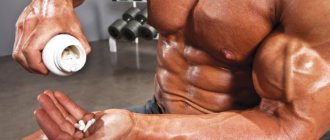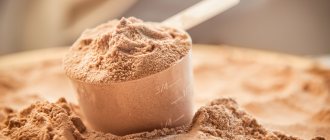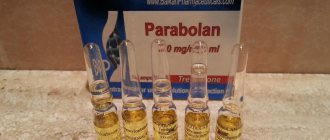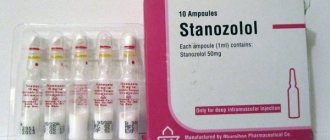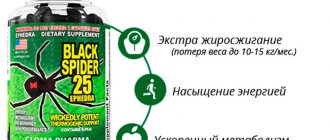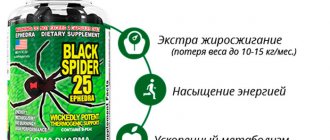- September 11, 2018
- Sports nutrition
- Tatyana Merzlikina
Creatine is a nutritional supplement that is popular among athletes. It allows you to effectively build muscle mass and significantly increase strength indicators. In the article, we will take a closer look at the composition and instructions for using the supplement, and also find out what to take with creatine.
Compound
Creatine - consists of three essential amino acids that are produced by the body in small quantities. Arginine, glycine and methionine are produced in the pancreas, adrenal glands and liver. These amino acids are of great importance for the athlete, with their help:
- stimulates the formation of growth hormone;
- tissues are restored;
- bone tissue and tendons are formed;
- spermatogenesis increases;
- nucleic acids are formed;
- tissue destruction is prevented.
The combination of these three amino acids stimulates protein metabolism well.
How to drink correctly
Many newcomers to sports ask how to drink keratin correctly and what to drink with it. But the first thing to consider is that you should not be negligent in taking this supplement. Failure to follow all rules can lead to health problems.
Regardless of the form of the drug (capsules, powder, solution), there are two methods of use in sports nutrition:
- Reception without loading. The most optimal way to use it. The duration of the course is one to two months.
- Reception with loading. An emergency measure. The duration of the intensive course is 5–7 days, then over the course of two to three weeks the amount of creatine used is halved.
Before taking this drug, it is recommended that you familiarize yourself with all the rules for taking it, read the instructions and find out what to take with creatine.
What to drink during training?
Before training and throughout the day, you should also monitor the flow of fluid into the body to avoid the risk of blood clots.
The average daily water consumption is 1.5-2 liters.
For a short workout with reduced activity, it is enough to drink simple spring water in small sips. In case of increased physical activity, water alone will not be enough. Special hypertonic drinks should be included. Adding caffeine to drinks can enhance efficiency and endurance during training.
If we are talking about professional sports, then the best option to replace moisture loss is to use special cocktails. Carbohydrate-electrolyte drinks (isotonics) effectively replenish the loss of mineral salts, saturate the blood with oxygen and provide enough energy for exercise.
To maintain water balance you can use:
- mineral water;
- vegetable and fruit juices;
- tonic drinks;
- tea;
- fresh fruits.
But athletes should avoid carbonated drinks and any liquid that contains sugar or dyes.
When choosing isotonics, you should take into account your level of physical activity, weight, age and training goal. In general, the basic composition of all carbohydrate-electrolyte drinks is the same and contains the required amount of microelements and vitamins. Glutamine, creatine, L-carnitine for increased fat burning and other substances can also be added.
Ideal hydration before and during competition
Athletes taking part in competitions must strictly monitor fluid balance before and during exercise.
A negative water balance before the start of a competition can lead to severe dehydration.
Therefore, an hour before the start, it is important to “stock up” on water by drinking 250-300 ml of liquid.
After finishing, you should immediately replenish the loss of moisture with the help of special drinks.
Let's take control of your water balance!
To effectively and easily monitor your water balance, today there are a number of useful applications.
- Waterbalance - the application allows you to control the water level in the body. At the same time, setting individual parameters (height, weight, age, gender and lifestyle) makes this control accurate and effective. Setting a timer in the app will help you receive reminder signals that it’s time to replenish your body’s water supply.
- Diagnosis of body composition - the application allows you to determine the exact limits within which a particular fluid is located (total, intracellular, extracellular). This application will be useful for professional athletes.
Reception with loading
This technique provides high results; it is considered effective, but at the same time very tough. During the loading cycle, the first five days take five grams of creatine four times a day. The supplement is taken in between meals; on training days, one of the doses must take place after finishing classes at the gym. What can you take creatine with? The supplement must be combined with a liquid with a high sugar content, this will allow all substances to be absorbed better and faster. After six days, the dose is reduced to two grams and taken once a day. During training, creatine is taken after exercise, and on all other days - in the morning. The full course lasts one month. Then there is a mandatory break for three to four weeks.
Research data
Scientific research shows that if an athlete takes 3-5 grams of creatine without a loading phase, after 28 days the reserves of this substance increase in the same way as in the presence of a loading phase. Of course, the loading phase helps to increase the total volume of this substance. However, the difference becomes insignificant after one month.
It is important to note one more detail. Muscles have limited capacity reservoirs for storing creatine. If you consume 20 grams of this substance daily, maximum muscle activity will be achieved within two days. By the third day, creatine begins to be excreted from the body by the kidneys along with urine. Therefore, it makes sense to take large doses of creatine only in the first three days, after which up to 60% of the substance will be naturally removed from the body.
Reception schedule
Beginners are interested not only in what to take with creatine, but also in the dosage schedule. Experts recommend consuming creatine immediately after training. It is at this time that metabolism accelerates and the substance is better absorbed. Taking creatine before training will not bring the desired effect; in addition, in this case, water balance disturbances may occur during the training process. Also, you should not use the supplement during the workout itself. This can lead to accelerated dehydration of the body.
On non-training days, experts advise drinking creatine in the morning; it is during this period that nutrients are absorbed most quickly.
When should I take it?
The process of consuming creatine usually does not have a clear connection to the training schedule and time of day, but many experts recommend taking it immediately after training sessions. The daily dose can be taken at once or twice (this is according to personal wishes). Dividing the daily dosage makes sense if the dose is more than 10 g per day. Taking into account the unexpressed tonic effect of creatine, it is best to use it in the morning.
The quality of creatine made in Europe and North America differs slightly. Therefore, when choosing sports nutrition of this type, you can focus on prices. Creatine powder is the cheapest option.
Duration of admission
Creatine is a very stable substance; it can remain in the human body for a very long time. Therefore, during a loading course, the supplement is drunk at twenty grams per day for only five to six days. In this case, during a maintenance course, high levels of creatine remain in the muscles for 12 weeks, and only then begin to subside.
When taking the supplement according to the standard regimen, it is recommended to limit use to two months and then take a break. At the end of the course, there will still be a sufficient amount of creatine in the muscles to maintain tone.
The price of an annual course of creatine may differ significantly when taken using different methods.
Let's start with the fact that there are a huge number of recommendations on how to take creatine: from manufacturers, professionals, scientists and sellers.
The recommended figures in different methods differ significantly.
To illustrate the situation, let's give an example.
The table below compares the cost of an annual course of creatine (to better feel the difference) when taking it using the four most common methods today. Compare the difference in quantity and cost: the difference for the “cheapest” and the most “expensive” methods reaches 6 times! (When calculating, the price of 33 g of creatine is assumed to be $1 (1 kg ~ $30), according to a popular Russian online store.)
| Calculation of the cost of creatine for 1 year using four different methods of administration |
| Cycle duration — 6 weeks (42 days) “Loading” phase — 5 days “Maintenance” phase — 30 days “Unloading” phase — 7 days Calculation for 9 cycles (54 weeks, ~ 1 year) |
| Method 1 Recommended by most manufacturers “Loading” phase: 25 g x 5 days = 125 g “Maintenance” phase: 5 g x 30 days = 150 g Total for 1 cycle: 275 g / 33 = $8.3 Total for 9 cycles (~1 year): 8.3$ * 9 = 74.7$ |
| Method 2 Described in the popular magazine “Creatine Nature's Muscle Builder”, dedicated to the use of creatine for building muscle mass and increasing training intensity. Calculation for a man 95 kg, average level of training “Loading” phase: 17 g x 5 days = 85 g “Maintenance” phase: 9 g x 30 days = 270 g Total for 1 cycle: 355 g / 33 = $10.8 Total for 9 cycles (~1 year): 10.8$ * 9 = 97.2$ |
| Method 3 Recommended by scientists scheme “Loading” phase: 20 g x 5 days = 100 g “Maintenance” phase: 2 g x 30 days = 60 g Total for 1 cycle: 160 g / 33 = 4.8$ Total for 9 cycles (~1 year): 4.8$ * 9 = 43.2$ |
| Method 4 Real example. Method used by one of the athletes and described in “Creatine Nature's Muscle Builder”. Cycle - 10 weeks, 4 training days per week “Loading” phase: 40 g x 7 days = 280 g “Maintenance” phase: 18 g x 27 days = 486 g (rest days), 24 g x 36 days = 864 g ( days of training) Total for 1 cycle: 1630 g / 33 = 49.4$ Total for 5 cycles (~1 year): 49.4$ * 5 = 247$ |
The cost of creatine differs by 2-6 times when taken using various popular methods; The cheapest method recommended by scientists is as effective as the most expensive
We recommend : BCAA amino acids: why are they needed in bodybuilding?
Before/after meals
There is a lot of controversy about taking the drug before or after meals. Previously, it was believed that the acidic environment of the stomach could destroy the substance, so it was recommended to drink creatine before meals. It was also indicated that in this case the absorption rate increases.
Over time, this opinion was refuted; at the moment it has been proven that the product is not destroyed in an acidic environment, so it can be consumed both before and after meals. Experts advise drinking creatine with juice or something sweet in between meals.
Various dosage regimens and their duration
At the moment, the best dosage regimen has not been determined. The only thing that scientists have established for sure is the recommended dose of the supplement. It is believed that it is optimal to drink 5-7 g of creatine per day.
Loading
Loading with creatine involves increasing the daily dose to 20 g, divided into 4 doses. This intense phase lasts from 4 to 6 days. During this time, the creatine content in the cells becomes maximum, and they stop storing it. Then it is enough to drink 2-3 g per day. It is important to note that the high concentration of creatine in the body remains for 3 months after completion of the loading.
Recent research shows that a loading phase is not necessary when taking creatine. Taking 3 g of creatine daily gives exactly the same results as loading followed by a maintenance dose of 2 g of the supplement.
Other studies show that better results can be achieved by taking 5g of creatine per day without a pre-loading phase. In this case, muscle volume and strength indicators grow even faster.
So is it worth using loading if there is no significant difference in using this phase or not? Let's consider the main arguments.
Pros of downloading:
- there are serious studies (however, it is worth remembering that they are beneficial to manufacturers);
- rapid results (which is also controversial, since the maximum concentration with and without loading will be achieved in the same period of time).
Disadvantages of downloading:
- high supplement consumption (increased cost of the course).
As a result, each athlete independently decides this issue. If necessary, you can consult a trainer or sports nutritionist.
Standard dosage regimen
If you decide to forego the loading phase, the maximum effectiveness of the supplement will be achieved after a month of use. The traditional creatine supplementation plan has a number of advantages:
- no muscle overload;
- less additive consumption;
- reducing the risk of side effects (for example, digestive disorders or reactions to other components included in the drug, in addition to creatine).
Can you drink creatine with water?
In order for creatine to reach muscle tissue, it needs special conditions, namely a high level of insulin in the blood. It is this hormone that helps increase cell permeability to various substances. Therefore, it is recommended to consume creatine with simple carbohydrates, as they cause a spike in insulin. It follows from this that when drinking water, you should add a few tablespoons of sugar or honey.
There are two effective ways to take creatine:
- 70 g of fast carbohydrates per 5 g of creatine;
- 50 g of carbohydrates and protein per 5 g of creatine.
Which carbohydrates are suitable and with which juice should I drink creatine? Grape juice is excellent because this berry contains glucose as the main carbohydrate, and a gainer based on maltodextrin is also suitable. When choosing a nutritional supplement, you should give preference to one that contains fast protein and maltodextrin; this combination will ensure rapid transport of creatine to the muscles.
Taking creatine does not always work
Researchers have clearly shown that additional use of creatine in the form of a special supplement does not always lead to an increase in its content in muscles 8,9: athletes who initially have low levels of creatine accumulate more effectively in their muscles when starting supplementation.
For those whose initial level is very high, the effect is minimal, or it may not exist at all .
About 30% of people belong to the second group! Especially athletes whose diet contains a lot of red meat and fish.
For them, additional creatine intake will be practically useless . (But even for them, there are some tricks on how to take creatine to get around the restriction. Read on).
Much of the research emphasizes the greater benefits of taking creatine in young people compared to older people. However, there is experimental evidence of benefit in older adults over 65, in whom creatine supplementation (5 g/day) increased total body weight, muscle mass, and strength during regular exercise 10.
Since plant foods do not contain creatine, vegetarians often have low levels and their bodies respond very well to additional intake 12.
Creatine also actively accumulates in untrained and atrophied muscles. One study showed that young people with partial muscle atrophy after cast removal recovered faster if they took creatine 11.
The effect of taking creatine is more pronounced in people with initially low creatine levels, in particular vegetarians. If the initial level is high, there may be no effect at all
We recommend : Anabolic steroids: what they are and how they work
Contraindications
Creatine, like other drugs, affects not only muscle tissue, but also the entire human body. In this regard, there are people who are contraindicated to use this remedy:
- with individual intolerance;
- with allergic reactions;
- with kidney diseases;
- asthmatics;
- with gastrointestinal diseases;
- athletes with asthma;
- pregnant and breastfeeding women;
- teenagers, since the use of the supplement is prohibited for minors, since creatine can cause improper development and formation of the body.
What effect can you expect from creatine?
The human body produces the nitrogen-containing acid creatine independently. It is involved in energy metabolism and the production of adenosine triphosphate (ATP). In other words, creatine works wherever energy is needed, including when gaining muscle mass.
The main goal of the supplement is to increase energy levels while maintaining ATP levels in the muscles during muscle contraction from physical activity. In addition, the supplement allows you to saturate the cells with calcium, retains water in the muscles, and thus the athlete’s strength indicators increase. While taking the supplement, you will be able to lift heavier weights, your endurance will increase, and therefore your workout performance.
Another important action is the elimination of lactic acid in the muscles, which causes fatigue, weakness and muscle pain after the training process. With the help of the supplement, muscles are restored faster, which means they grow faster.
But there will be no effect from creatine alone. This is a non-hormonal drug, so muscle growth can only be achieved in combination with proper exercise, a balanced diet and rest.
